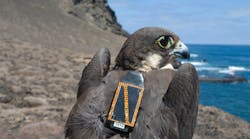As technology has advanced, one of the more unique applications to evolve has been the study of animals. Global Positioning System (GPS) and RF-identification (RFID) technologies, for example, have greatly enhanced researchers’ abilities to perform research. At the University of Amsterdam (UvA) Faculty of Science, a sophisticated bird-tracking system was recently developed using microelectromechanical-systems (MEMS) technology from STMicroelectronics.
These tracking systems are essentially data loggers, which can be attached to the backs of birds (see photo). To ensure that they will not impede the birds’ flight, the systems weigh as little as a 20-euro-cent coin. In terms of size, they are smaller than a car key. The trackers measure the birds’ GPS position every 3 s.
The tracker also collects acceleration and direction data from STMicroelectronics’ LSM303DLM digital compass. This compass integrates low-power, high-performance motion and magnetic sensing in a miniature form factor. The MEMS chip monitors the direction and vertical/horizontal orientation of the animal. It can therefore determine the body angle of birds flying in a crosswind.
The sensors in the tracker measure air temperature and the device’s internal temperature. A ZigBee transceiver manages wireless data communication to and from the device. Power is provided by a lithium battery, which is charged by a triple-junction solar cell. Data from the trackers is being shared among bird-research institutes and biologists to verify computer models that predict bird behavior and migration patterns.

